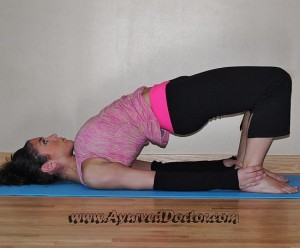 Setubandhasana is known as the bridge pose. In Sanskrit, Setu means bridge and bandha means binding. Hence, this asana is believed to be a binding bridge between the human body and mind, powerfully uniting the polarities in both. Yoga masters point out that four out of our five senses, namely seeing, hearing, smelling, and tasting are located in our face. This makes us forget about our connection with the body below the head on most occasions to an extent that we remain cut off from our own bodies. Our feet are the farthest from our head. Hence, the Setubandhasana helps us in re-establishing our bond with our feet and our entire body, both inside and outside.
Setubandhasana is known as the bridge pose. In Sanskrit, Setu means bridge and bandha means binding. Hence, this asana is believed to be a binding bridge between the human body and mind, powerfully uniting the polarities in both. Yoga masters point out that four out of our five senses, namely seeing, hearing, smelling, and tasting are located in our face. This makes us forget about our connection with the body below the head on most occasions to an extent that we remain cut off from our own bodies. Our feet are the farthest from our head. Hence, the Setubandhasana helps us in re-establishing our bond with our feet and our entire body, both inside and outside.
Procedure of Setubandhasana
- The first step in Setubandhasana is to lie on your back, keeping the hands straight on each side, with the palms facing down.
- You should slowly bend the knees, with the feet remaining parallel and pressed firmly to the ground, with the distance between them equivalent to the size of your hip. The bending of the knees should be to a level where the heels of the feet just reach the fingertips of your hands.
- You should inhale and exhale slowly in this position to relax your body and remove any tension.
- You should now press your feet firmly on the ground and lift your spine very slowly, vertebrae by vertebrae. Initially, you may find it difficult to reach the ultimate position, but the final position is when you are resting on the uppermost back vertebrae and your feet, with your fingers touching your heels.
- If necessary, you can place your hands on the hips to lift your back in the initial stages, so that the chest is pushed forward and the shoulders bear the burden of the lifted portion of the body, along with the feet.
- In this position, you will easily be able to feel the expansion and opening up of your chest and the connection and energy that the spine receives from this pose. This is the actual effect of the binding effect from this bridge pose, aptly named as Setubandhasana.
- You can hold this pose for 2-3 breathes and then slowly lower your body again vertebrae by vertebrae until you are again flat on your back.
- You can now stretch your arms and knees to lie fully prone on the floor before you start repeating this asana again. When you relax, you will feel the energy flowing into your chakras and through your entire body.
Variations of Setubandhasana
You can hold your hips when you have reached the final position and then lift one leg slowly until that leg is fully perpendicular at 90o ot your other leg, while keeping the other firmly on the ground. You can repeat it with the other leg, after returning the raised leg slowly to the ground.
Benefits of Setubandhasana
Since Setubandhasana is a back bending posture, it stretches the back, spine, neck and chest. Further, the stretching also stimulates the abdominal organs, the lungs, and the thyroid gland, strengthening them effectively. It increases the flexibility of the spinal cord. Further, the Setubandhasana also helps in handling the following conditions.
- Stress
- Anxiety
- Mild depression
- Insomnia
- Sinusitis
- High blood pressure
- Headache and backache
- Indigestion
- Osteoporosis
- Menstrual discomfort and menopause
- Tired legs
- Fatigue
The legs and feet should be parallel and you should avoid squeezing your buttocks very tightly when doing this asana. Further, you should ensure that the throat, neck and jaw are relaxed when you are lifting the body. You should also do one or two forward bending counter poses after this asana. Your yoga master will be able to guide you in becoming perfect in this asana.

